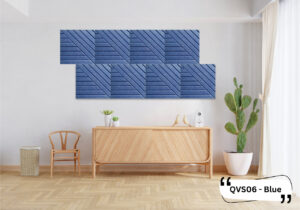
Are you tired of noisy neighbours, traffic sounds, or the echo of your own music bouncing off the walls? If you’re a homeowner seeking serenity or a music enthusiast looking to create a perfect sound environment, soundproofing is essential. But where do you start? This listicle will guide you through the best materials for soundproofing and provide tips on how to use them effectively.
The Importance of Soundproofing
Soundproofing isn’t just about reducing noise. It’s about creating a more comfortable and enjoyable living space. For homeowners, it can mean a quieter home, better sleep, and increased property value. For music enthusiasts, soundproofing ensures that your creativity doesn’t disturb others and that you can enjoy every note without unwanted echoes.
Top Soundproofing Materials
1. Acoustic Panels
Why They Work: Acoustic panels are designed to absorb sound waves, reducing echo and reverberation within a room. They’re often made from foam or fabric-covered fibreglass and come in various sizes and designs.
Best For: Home theatres, recording studios, and any room where sound clarity is crucial.
Installation Tips: Mount them on walls or ceilings using adhesive strips or nails. Place them strategically where sound reflections are most likely to occur.
2. Soundproof Curtains
Why They Work: These heavy-duty curtains are made from dense materials that block and absorb sound. They also help insulate against heat and cold.
Best For: Bedrooms, living rooms, or any space with large windows.
Installation Tips: Hang them as you would regular curtains, but ensure they cover the entire window area and extend beyond the frame for maximum effectiveness.
3. Mass Loaded Vinyl (MLV)
Why They Work: MLV is a flexible, dense material that adds mass to walls, floors, and ceilings, reducing sound transmission. It’s known for its high sound-blocking capabilities.
Best For: Walls, floors, and ceilings in both residential and commercial spaces.
Installation Tips: Attach it directly to studs or existing walls using nails or screws. Cover with drywall for a finished look.
4. Door Sweeps and Seals
Why They Work: Gaps around doors can allow a significant amount of sound to pass through. Door sweeps and seals block these gaps, reducing noise leakage.
Best For: Entry doors, interior doors, and garage doors.
Installation Tips: Install door sweeps at the bottom of doors and adhesive weatherstripping around the edges.
5. Soundproof Insulation
Why They Work: Specialised insulation materials, like rock wool or fibreglass, are excellent at trapping sound within walls, floors, and ceilings.
Best For: New constructions, renovations, or any space where you have access to wall cavities.
Installation Tips: Install between wall studs or floor joists during construction or renovation.
6. White Noise Machines
Why They Work: While not a traditional soundproofing material, white noise machines create a consistent background sound that can mask unwanted noise.
Best For: Bedrooms, offices, and nurseries.
Installation Tips: Place the machine at a distance from your bed or desk. Experiment with different sounds and volumes to find what works best for you.
How to Choose the Right Materials for Your Space
Factors to Consider
- Room Size: Larger rooms may require more extensive soundproofing solutions.
- Purpose: Consider what you’re trying to achieve—sound absorption, sound blocking, or both.
- Budget: Some materials are more expensive than others, so balance cost with effectiveness.
Combining Materials for Maximum Effectiveness
Don’t be afraid to mix and match different materials to achieve the best results. For example, using acoustic panels and soundproof curtains together can significantly enhance your room’s soundproofing capabilities.
DIY Soundproofing Tips
Easy Installation Steps for Each Material
- Acoustic Panels: Clean the wall, apply adhesive, and press the panel firmly.
- Soundproof Curtains: Use sturdy curtain rods and ensure full window coverage.
- Mass Loaded Vinyl: Measure and cut to size, then attach with nails or screws.
- Door Sweeps and Seals: Clean the door surface, align the sweep, and screw it into place.
- Soundproof Insulation: Fit between studs, cutting to size as needed.
- White Noise Machines: Place at ear level and adjust the volume.
Common Mistakes to Avoid
- Ignoring Gaps: Small gaps can undermine your efforts, so seal all openings.
- Overlooking Ceiling and Floors: Sound can travel through all surfaces, not just walls.
- Using Inadequate Materials: Invest in high-quality materials for the best results.
Conclusion
Soundproofing your space doesn’t have to be complicated or expensive. By using the right materials and following our tips, you can create a quieter, more enjoyable environment. Ready to get started? Explore a selection of soundproofing products and take the first step toward a more peaceful home or studio.
